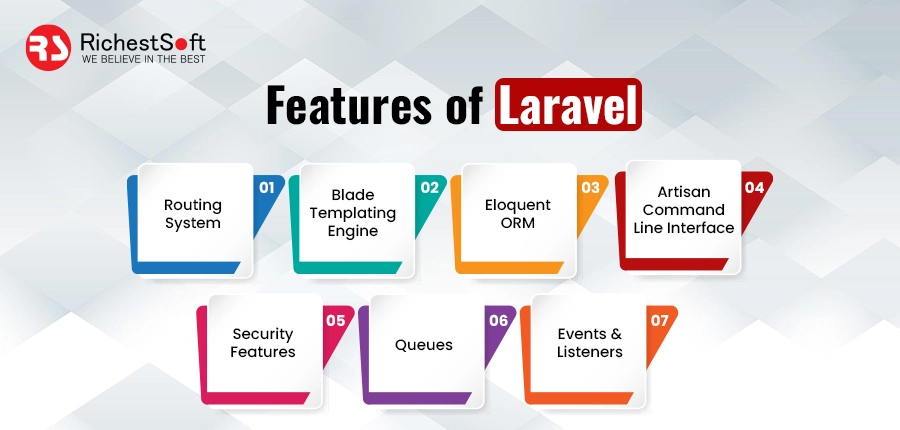Laravel is a prevalent open-source PHP platform that has gained tremendous popularity among web developers around the globe. Its modular packaging system, smart syntax, and robust features make it a top choice for web development. Laravel’s popularity is further fueled by its powerful capabilities and multiple advantages to web developers. Over 5.5 million websites worldwide use Laravel, according to recent reports by Wappalyzer. It is not surprising that companies and web developers highly covet Laravel, given its many benefits.
This blog will detail the features and benefits of Laravel PHP frameworks.
So, let us explore the reasons behind Laravel’s skyrocketing popularity as one of the most sought-after PHP frameworks in the industry.
Popular Features of Laravel
Here are some beneficial features of Laravel that make it the best choice for web developers.
✅ Routing System- One of the essential features of Laravel is its routing system. It authorizes web developers to determine application routes and URLs in a straightforward and organized way. The routing system also helps make creating APIs, RESTful routing, and web services easy.
✅ Blade Templating Engine – Laravel’s Blade templating engine is a straightforward yet robust tool for making views in web development. It authorizes web developers to define reusable templates that can be used across different application pages. It assists in developing a consistent and clean user interface.
✅ Eloquent ORM – Laravel’s Eloquent ORM is a robust tool for database interchange. It provides an easy-to-use interface for database functions and helps connections between database tables. With Eloquent ORM, developers can write less code and focus more on web development’s business logic.
✅ Artisan Command-Line Interface – Laravel’s Artisan command-line interface is a robust tool for web developers. It delivers a complete range of commands for tasks such as running database migrations, generating boilerplate code, and running unit tests. The Artisan CLI can help web developers to save time and automate repetitive tasks.
✅ Security Features – Laravel has various security features that authorize web developers to make secure web applications. These advanced features protect against cross-site request forgery (CSRF) attacks, cross-site scripting (XSS) role-based access control, and secure password hashing.
✅ Queues – Laravel’s queue system authorizes web developers to handle time-consuming tasks in the background. It can enhance application performance and user experience. Queues can be used to process tasks such as sending emails, generating reports, or processing large dataset
✅ Events and Listeners – Laravel’s event and listener system authorizes web developers to build loosely-coupled and modular applications. Events represent something that has occurred in the application, and listeners respond to those events. It adds new functionality to the web application without quickly changing existing code.
Laravel is a dynamic PHP framework that delivers various features to authorize web developers to create web applications more efficiently and quickly. Its templating engine, routing system, elegant syntax, queues, ORM, CLI, security features, and event system make it the perfect choice for web developers across the globe. With its complete documentation and active community support, Laravel is ideal for beginners and experienced web developers.
Read More: Hire Laravel Developers – Top Tips, Benefits and Cost
Benefits of Using the Laravel Framework

Here are some essential benefits of using Laravel PHP frameworks for web development.
✅ Quicker Development – One of the main advantages of using Laravel is its ability to accelerate the whole development process. Laravel proposes pre-built functionalities such as authorization, authentication, and routing, authorizing web developers to concentrate on making the application’s core features. It significantly decreases the time and effort required for development.
✅ Built-in Tools – Laravel has a range of built-in tools that authorize web developers to boost productivity and simplify their workflow. These tools include Artisan CLI for generating boilerplate code and running commands, Blade templating engine for creating views, and Eloquent ORM for database interactions. These tools allow web developers to write less code and focus more on the application’s business logic.
✅ Modular and Scalable Architecture – Laravel’s modular and scalable architecture makes it straightforward for app developers to build applications that can be scaled to handle high traffic and data. It authorizes app developers to break down the application into independent modules, which can be smoothly maintained and updated without impacting the whole application.
✅ High-level Security Features – Laravel delivers advanced security features authorizing web developers to create secure web applications. These features possess hashed passwords, input validation, and CSRF protection. Laravel also supports two-factor authentication for securing software applications controlling sensitive data.
✅ Easy Database Migration and Management – Laravel’s migration and schema builder feature makes it easy for web developers to manage database changes and updates. This feature authorizes web developers to modify database structures without manually making changes to the database. Laravel also supports multiple database systems, making it a versatile framework for web development.
✅ Good Documentation and Community Support – Laravel’s vast web developers and user community contributes to its growth and development. The framework is well-documented, making it easy for web developers to find answers to their questions and resolve any issues. The active community also supports and assists web developers facing challenges using the framework.
Laravel is a positively desirable framework for web development projects due to its multiple advantages. Its capability to expedite development, modular design, built-in tools, scalable architecture, advanced security features, effortless database migration and management, comprehensive documentation, and community support make it a reliable and helpful option for web application building. Professional developers can leverage Laravel’s advanced features to create compelling and secure web applications that fulfill their client’s necessities.
Security Considerations With the Laravel Platform

Web application protection has become the utmost priority as more and more businesses shift to online platforms. One of the most well-known PHP web development frameworks, Laravel, delivers various security features. As with any technology, learning potential security threats and how to counter them is paramount. The Laravel framework and some security issues are discussed here, along with tips on protecting your web application.
✅ Input Validation – One of the most common ways attackers can exploit web applications is through input validation. Laravel delivers built-in validation rules to provide safe user input that does not contain malicious code or scripts. These validation rules and sanitizing user input are necessary to stop attacks like cross-site scripting (XSS) and SQL injection.
✅ Authentication and Authorization – User authentication and authorization are supreme components of any secure web application. Laravel delivers an impressive authentication system with features like two-factor authentication, password hashing, and user lockout after forgotten login attempts. It is also critical to execute proper authorization controls to guarantee that users can only access the parts of the application that they are authorized to.
✅ Password Management – Passwords are usually the most vulnerable link in web application security. Laravel delivers password hashing, ensuring that passwords are stored securely and not effortlessly accessible even if the database is compromised. Also, implementing password complexity rules and periodic password changes can further improve the application’s security.
✅ Cross-Site Request Forgery (CSRF) Protection – CSRF episodes happen when a user unknowingly submits a request to a web application on behalf of an attacker. Laravel delivers built-in CSRF protection, which develops and verifies tokens to confirm that requests are legitimate and not malicious.
✅ Security Updates – Security exposures can be uncovered in any technology, including Laravel. To save your software application from known vulnerabilities, it is crucial to remain up-to-date with the most delinquent security patches and updates. Laravel delivers regular security updates, and updating your application to the most recent version is suggested.
Common Issues With the Laravel Platform and How to Fix Them

Laravel is a famous and widely used PHP framework for web application development. While Laravel delivers many edges, like rapid development and modular design, web developers can face common issues when using this platform. Here are some familiar problems web developers face while working with Laravel and how to correct them.
1. Migration Issues: Migrations are a crucial part of Laravel’s database system. They authorize web developers to modify the database schema in a version-controlled method. However, sometimes migrations can fail for different reasons, such as wrong syntax or column types.
Solution
It is necessary to double-check the syntax and ensure that the migration is compatible with the Laravel version you are operating while resolving this issue. You can also roll back migrations and try again or create a new migration to fix the problem.
2. Routing Issues:
Laravel’s routing system is one of its most important benefits. However, routing issues can occur when the routes are incorrectly defined, resulting in a “404 not found” error.
Solution
Double-check the route definitions, including the URI and HTTP methods, to resolve routing problems. Use the correct syntax when defining routes and ensure the suitable controller and process are called.
3. Performance Issues:
Performance problems can happen in any web application, and Laravel is no exception. Issues can occur for different reasons, such as incorrect query optimization or inefficient code.
Solution
You can use Laravel’s built-in caching system to resolve performance problems, significantly enhancing performance. Also, avoid excessive database queries, optimize queries and database operations, and use efficient coding practices.
4. Authentication and Authorization Issues:
Laravel delivers a robust authentication and authorization system, but problems can occur when executed incorrectly, resulting in access errors or security vulnerabilities.
Solution
Ensure the authentication system is implemented correctly and securely to enhance authentication and authorization issues. Use Laravel’s built-in authorization system to limit entry to specific resources and use encryption to secure sensitive data.
Tips for Getting Started with Laravel

Getting started with Laravel can be challenging for novices. Here, we will examine some suggestions to help you start with Laravel and make your development faster.
- Install Laravel: First, install it on your system. You can install Laravel using Composer, a notable PHP dependency manager.
- Understand the Structure: In Laravel, the application logic is divided into three layers based on the MVC (Model-View-Controller) technique. Comprehending this structure is essential to building a Laravel application. The model layer manages data storage, the view layer handles user interface design, and the controller layer handles application logic.
- Use Artisan: Laravel provides a command-line interface called Artisan, which can support you in performing different tasks, such as running database migrations, generating boilerplate code, and clearing the application cache. Artisan can save you time and effort in your development approach.
- Leverage Blade Templates: Laravel operates a templating engine called Blade, which proposes several advantages over other templating engines. Blade authorizes you to write clean, legible code by dividing the application logic from the view layer. It also delivers features such as template inheritance, conditional statements, and loops.
- Use Eloquent ORM: Object-relational mapping (ORM) tool, Eloquent, makes working with databases easy and intuitive. It gives a simple and intuitive syntax for reading, creating, updating, and deleting database records.
- Utilize Middleware: Laravel delivers middleware, which permits executing actions before or after a request is processed. Middleware can be used for authorization, authentication, and caching tasks. Using middleware can assist you in writing cleaner and better efficient code.
- Take Advantage of Packages: Laravel has an extensive ecosystem of packages that can support you in extending the functionality of your web application. Packages can deliver payment processing, authentication, and file-uploading features. Using packages can preserve your time and effort in your development technique.
Following these tips can streamline the methodology and efficiently create powerful web applications. By comprehending the structure of Laravel, using Artisan, Blade, and Eloquent, leveraging middleware, and taking advantage of packages, you can quickly build potent and efficient applications.
FAQs
Q1: How does Laravel help in speeding up the development process?
Ans: Laravel’s modular architecture and built-in tools make it straightforward to write clean, organized code that can be fast reused across numerous projects. Also, Laravel’s framework has a powerful command-line interface that automates many standard development tasks, authorizing web developers to work better efficiently.
Q2: How does Laravel ensure the security of web applications?
Ans: Laravel has several built-in security advanced features, including CSRF protection, hashed password storage, and SQL injection prevention. Also, the platform makes it clear to execute best practices for security, such as password sophistication controls and two-factor authentication.
Q3: Is Laravel suitable for beginners?
Ans: Laravel is a friendly platform for beginner appreciation of its straightforward and complete documentation, active community support, and concise syntax. Also, the framework has many built-in tools and features that make it easy for beginners to start web development.
Conclusion
Laravel, an efficient and widely used PHP framework, has gained popularity due to its multiple features and advantages. It makes it a preferred choice for a beginner, an easy-to-learn syntax and structure, and advanced developers. Its modular architecture, built-in tools, easy database migration, scalability, security features, and management capabilities make it a dedicated framework for developing web development. Also, Laravel’s outstanding documentation and strong community support have further hardened its prominence in the developer community. If you are looking for a robust, efficient, and secure PHP framework for your web development project, Laravel is worth considering.







Leave a Reply